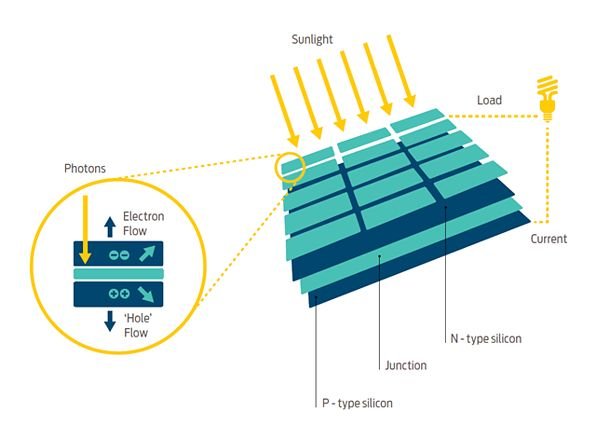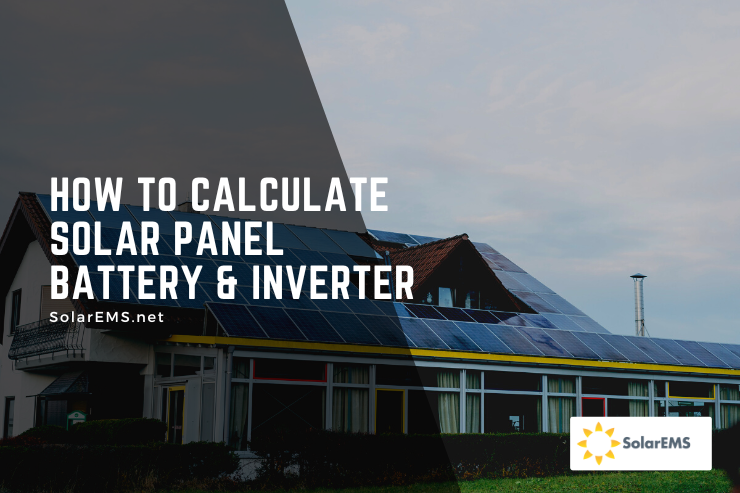When we decide to install a solar panel in our residential or commercial space, the first question that comes to mind is about the size of solar panel battery and inverter which would be appropriate and sufficient. There is no shortcut to arriving at that solution, but there is a way which one can follow to calculate it.
Solar panels work best when they get direct sunlight and are generally installed on rooftops where they can get the maximum amount of sunlight. They are made up of solar cells, which have silicon wafers and generate direct current (DC) electricity that flows in only one direction. These DC electric currents will be converted into alternating current (AC), which is used by the electrical equipment in the home.

In general, if you use solar energy at home, you will receive cost-saving benefits from the country’s electrical boards or authorities based on the electricity saved. If you have negative bills, then you will get the total amount as a measure of overproducing or using renewable energy for electricity. That’s what motivated us to install it at our place.
How to calculate solar power is as easy as knowing the correct size of the batteries and power inverter to be installed because the solar power system will not work efficiently if everything is not properly matched. Here, we can help you with how to calculate solar panel battery and inverter size as per your requirements.
Steps in calculating the size of the solar panel battery and inverter
Solar panels are the perfect solution for using a renewable source of energy, which is sunlight, to produce electricity. Every residential or commercial space is trying to install solar panels, which can last for a long time. There are five steps that we have followed to know how many solar panels with an inverter and battery we need at our place, from calculating the load wattage at our place to finally calculating the number of solar panels.
- Calculate the load at our place
The first step in calculating the need for a solar panel inverter and battery size is to determine the load at my location. Calculating the correct amount of load wattage is very important for installing the proper solar battery sizing and inverter sizing. The load wattage is the total amount of electricity used in a place.
- First, we need to turn on all the devices in our place, the lights, refrigerators, fans, etc.
- After that, we use a clamp meter, which is used to measure the current a wire is carrying. It will show the result in an amp (short form of an Ampere). The results that come out should be converted into a standard measure of electricity, which is watts.
- Example: Suppose the clamp meter shows 15 amps and the voltage range is somewhere around 120 volts. The total load used at my house in a day will then be 15A * 120V = 1800W, as shown in our last year’s electricity bill’s estimated daily usage.
- Calculate the battery backup storage
The second step is to calculate how much battery backup storage is needed.
- To put it simply, how long do I need a regular electricity supply if there is a power cut? Let us assume it to be 6 hours everyday.
- Then, the solar battery storage calculator will tell me that the total backup I require will be equal to the backup duration multiplied by the total load usage. The total backup watts required will be 6 * 1800W, or 10,800W.
- Calculating the battery size
The third step is to calculate the solar battery size, which is equal to the backup time divided by the battery storage.
- There are two types of batteries available in the market: lead-acid and lithium.
- The lead-acid battery generally used is of size 150Ah and can store 1300W of electricity. If I install the lead acid battery, then the required battery size will be 10,800W divided by 1300W, which is equal to around 9 batteries.
- The lithium battery is available in sizes of 150Ah and can store 5,000W of electricity. If I install the lithium battery, then the required battery size will be 10,800W divided by 5000W, which is equal to around 2 batteries.
- Calculating the inverter size
The next and most crucial step is to do the inverter size calculation. A good-quality and properly sized solar battery with an inverter will help with the connection of the solar panel to the battery and the grid. The function of the solar power inverter is to flow a stable voltage to the output, which can help reduce the chances of overcharging and reduce backflow. It can help in converting the direct current of the solar panels to the alternating current needed to support the electrical equipment and export it to the grid. It also helps in monitoring the photovoltaic arrays of the panels, battery, grid, and loads.
- The formula for calculating inverter size is to multiply the load requirement by 20% and then add it to the total load.
- Therefore, the total inverter size I need is (1800W * 20% + 1800W) = 2160W, which is equal to 2.16kWh.
- Solar panel computation
The last step is to calculate the solar panel requirement at the site. The solar panel power calculation is calculated in watts or kilowatt-hours according to the amount of electricity they produce in an hour of direct sunlight. However, it is very important to know that it will be dependent on the direct sunlight it will get because the place or area where it is installed will be a direct factor in that.
- For the solar panel calculations, it is important to know that they generate the DC (direct current) voltage, which ranges between 22V and 50V.
- The solar panel capacity formula will be equal to the required total load in a day divided by the number of peak sunlight hours. Therefore, the solar panel capacity that I require will be 1800W divided by 5 hours of peak sunlight in a day, which is equal to 360W, or 0.36kWh.
- Let’s say the available size of a solar panel is 250W or 0.25kWh, then the number of solar panels that I will require to install at my place will be 0.32kWh divided by 0.25kWh, which is around 2 solar panels.
- These 2 solar panels are sufficient if I get the full power from the solar panel, but that is not true because the solar panel will lose energy because of dirt and dust, reflection, array mismatch, thermal losses, etc.
- If the solar panels lose 20% of their solar energy in a day, the number of solar panels I need is (2 + 2 * 20%), which equals 3 solar panels.
To conclude, solar panel energy is not just helpful in terms of renewable and emission-free ways to produce electricity, but it also helps with the way to save money if we correctly know how to calculate solar panel battery and inverter size as per our requirements.
Calculator
Frequently Asked Questions (FAQs)
How do you calculate the battery backup time for solar panels?
The formula used by the solar battery backup calculator to calculate how much battery backup will last for your solar panels is battery amp hours multiplied by battery size and percentage of efficiency.
Let’s assume, for example, that you’re using a lead acid battery with a capacity of 150Ah at 12V and a 75% efficiency, and your total electricity consumption at any given time is 200W.
Then, the backup time will be (150 * 12 * 0.75)/ 200W = 6.75 hours.
How do you calculate solar power in kW?
You can easily calculate solar power in kWh, which is a measure of how much electrical energy you’re using in an hour.
To calculate the size of solar power in kWh, you must first know the details of daily electricity usage in kWh, which can be obtained from the previous month’s electricity bill, as well as the peak sun hours, which can be obtained from a sun hours chart in the area where you live.
After that, use the solar power calculation formula for finding out the requirement of the solar system size, which is the value of the daily electricity usage divided by average sun peak hours, and then further multiply it by the efficiency factor.
Can I use a solar panel with an inverter battery?
The inverter battery and solar panel can go hand in hand. If you live in a place where you have a lot of power cuts, the conventional inverter will not be able to charge fully. Therefore, solar inverters can be used to convert the DC generated by solar panels into a usable form. The different types of solar inverters available on the market are:
– Central inverters: They are suitable for industrial areas and have an output of at least 400kW of electricity.
– Microinverters: They are suitable for places where there is not sufficient sunlight and are installed on the back of the solar panel. They have a power output of around 250W.
– String inverters: They are suitable for residential and small business areas.
– Grid-tied inverters: They are good for urban areas, and they do not require the installation of batteries because these places are very well-versed in the proper connection.
– Off-grid inverters: They are suitable for rural areas where it is not possible to have direct connectivity with the grid.
How many batteries do you need for a 5-kilowatt solar system?
To know how many batteries I need for my solar system for a 5kW solar system, first, it is important to know that it depends on various factors such as battery capacity or size, voltage, climate, discharge, etc.
– A 100 amp hour battery can approximately store 1200W at 12V if 100W of electrical equipment is running.
– The nighttime consumption of electricity will surely be less than the daytime consumption. So, if you use 5kWh of electricity at any point in time, you’ll need to install four 100 amp hour 12-volt batteries.
Can we connect the solar panel directly to the inverter battery?
Yes, we can directly connect the solar panel’s inverter battery. The wiring to the panels can be done in two ways, one in series and the other in parallel.
– The in-series system is where a single wire is attached to the grid and is advantageous in the case of increasing voltages and the same current level. However, if one solar panel’s wiring breaks, then the other panels will also fail.
– In parallel, it is advantageous in the case of an increasing current level and the same voltage. However, if one solar panel’s wiring broke, then the other panels would continue to work because there are multiple wires attached to the grid.
This article is better than any other article because it provides a simple step-by-step guide on how to calculate the solar panel battery and inverter size with examples. Also, it will help the reader find step-by-step solutions to all the questions related to the topic.
Meet the Authors
Dax Linwood is a knowledgeable and experienced writer in the field of renewable energy, with a core expertise in solar energy. With a passion for sustainability and a commitment to advancing the adoption of clean energy, Dax's writing is both informative and engaging. He has worked on numerous solar energy projects, including solar panel installation and maintenance, and has a deep understanding of the technology and its benefits. Dax's expertise and dedication to the renewable energy industry make him a valuable resource for those looking to learn more about solar energy and its impact on the environment.

